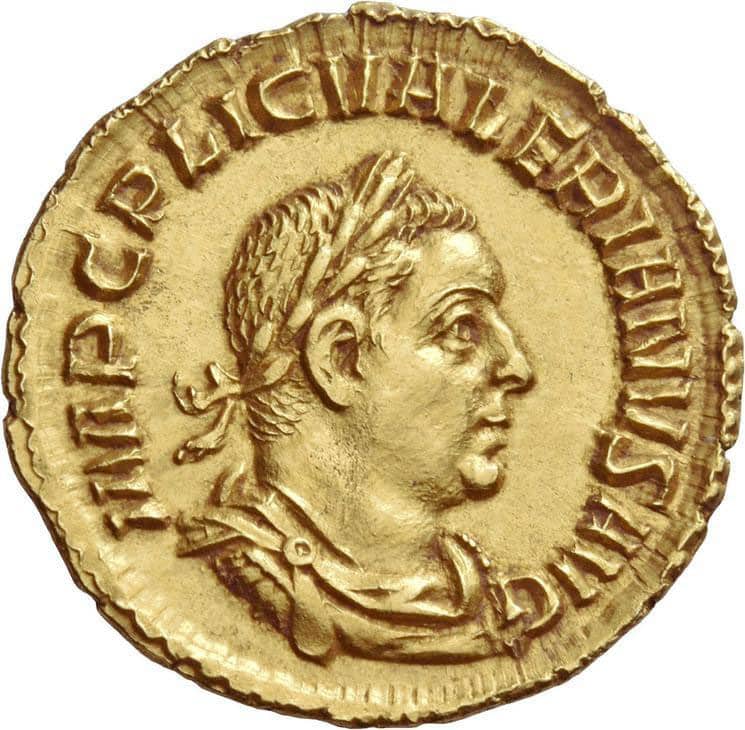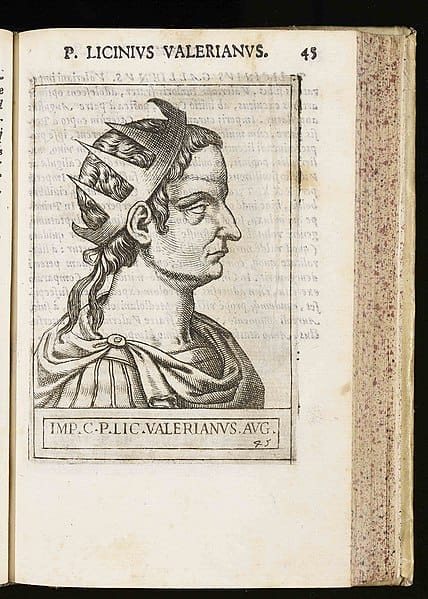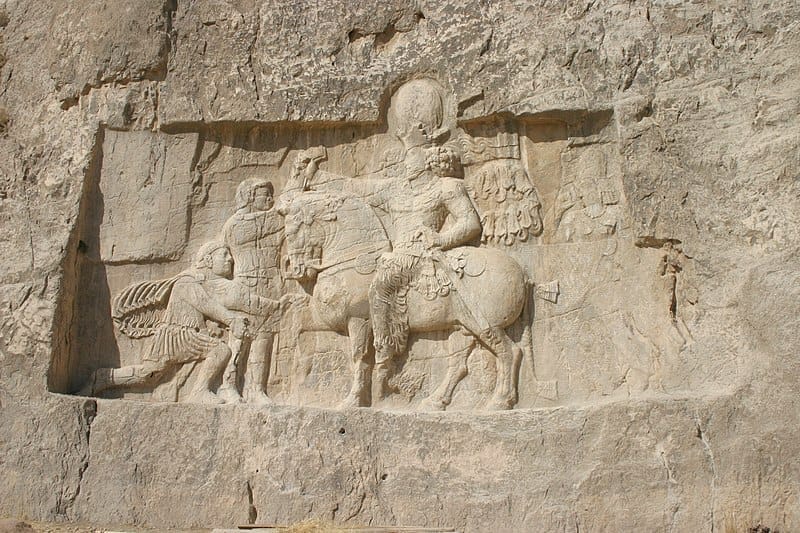Life: AD c. 195 – 260

- Name: Publius Licinius Valerianus
- Born AD ca. 195.
- Consul in AD 230’s.
- Became emperor in October AD 253.
- Wife: Egnatia Mariniana (two sons; Publis Licinius Egnatius Gallianus; Publius Licinius Valerianus).
- Captured by Persians in June AD 260. Died in Captivity.
Early Life
Valerian, a descendant of a distinguished family from Etruria, was born in about AD 195. He served as consul in the 230s under Alexander Severus and was one of the leading supporters of the Gordian rebellion against Maximinus Thrax in AD 238.
Under later emperors, he was much appreciated as a stalwart senator, a man of honor one could rely on. Emperor Decius granted him special powers to oversee his government when he embarked on his Danubian campaign. He dutifully put down the rebellion of Julius Valens Licianus and the senate while his emperor was fighting the Goths.
Valerian Military Success
Under the subsequent reign of Trebonianus Gallus, he was entrusted with the command of the powerful forces of the Upper Rhine in AD 251, proving that this emperor, too, deemed him a man he could trust. When, alas, Aemilian rebelled against Trebonianus Gallus and led his troops against Rome, the emperor called upon Valerian to come to his aid. However, Aemilian had already advanced so far that it was impossible to save the emperor.
Becoming an Emperor
Though Valerian marched on toward Italy, determined to see Aemilian dead. With Trebonianus Gallus and his heir both killed, the throne was now free to him. When he reached Raetia with his troops, the 58-year-old Valerian was hailed emperor by his men (AD 253). Aemilian’s troops soon after murdered their master and vowed allegiance to Valerian, not wanting to face a fight against the formidable army of the Rhine. Their decision was at once confirmed by the Senate. He arrived at Rome in the Autumn of AD 253 and elevated his forty-year-old son Gallienus as full imperial partner.

But these were hard times for the empire and its emperors. German tribes invaded the northern provinces in ever greater numbers. So, too, in the East, the coastline of the Black Sea continued to be devastated by seaborne barbarians. In the Asian provinces, great cities like Chalcedon were sacked, and Nicaea and Nicomedia were put to the torch. Urgent action was required to protect the empire and reestablish control. The two emperors needed to move swiftly.
The Division of the Roman Empire
Valerian’s son and co-Augustus Gallienus now went north to deal with the German incursions on the Rhine. Valerian himself took the east to deal with the Gothic naval invasions. In effect, the two Augusti split the empire, dividing the armies and territory between each other, giving an example of the split into Eastern and Western empires, which was to follow in a few decades.
But his plans for the east came to very little. First, his army was hit by pestilence, then a far greater threat than the Goths emerged from the East. Sapor I (Shapur I), king of Persia, now launched another attack on the reeling Roman empire. Whether the Persian assault began early into Valerian’s or shortly before is unclear.
Persian Raids
But Persian claims to have captured as many as 37 cities are most likely true. Sapor’s forces overran Armenia and Cappadocia and, in Syria, even captured the capital Antioch, where the Persians set up a Roman puppet emperor (called either Mareades or Cyriades). However, as the Persians invariably withdrew, this would-be emperor was left without any support, was captured and burnt alive.
The reasons for the Persian withdrawal were that Sapor I was, contrary to his own claims, not a conqueror. His interests lay in looting the Roman territories rather than acquiring them permanently. Therefore, once an area had been overrun and sacked for all it was worth, it was simply abandoned again. So, by the time he arrived in Antioch, the Persians had most likely already retreated.
Usurper of Emesa
One of his first acts was to defeat and crush the rebellion of the high priest of the notorious deity of El-Gabal at Emesa, Uranius Antoninus, who had successfully defended the city against the Persians and, therefore, had declared himself emperor.
Valerian campaigned against the marauding Persians for the next years, achieving some limited success. Not much detail appears to be known of these campaigns, other than in AD 257, he did achieve a victory in battle against the foe. In any case, the Persians had largely withdrawn from the territory they had overrun.
Sapor I Second Attack
But in AD 259, Sapor I launched yet another attack on Mesopotamia. He marched on the city of Edessa in Mesopotamia to relieve this city from the Persian siege. But his army suffered severe losses by fighting, but most of all, by plague. Hence, Valerian, in April or May AD 260, decided it would be best to sue for peace with the enemy.
Envoys were sent to the Persian camp and returned with the suggestion of a personal meeting between the two leaders. The proposal must have appeared genuine, for emperor Valerian, accompanied by a small number of personal aides, set out to the arranged meeting place to discuss the terms for bringing the war to an end.
Valerian Unknown Fate
The peace negotiations were merely a trick by Sapor I. Valerian rode right into the Persian trap, where he was taken prisoner and dragged off to Persia. Nothing more was ever heard again of emperor Valerian other than a disturbing rumor by which his corpse was stuffed with straw and preserved for ages as a trophy in a Persian temple.

It is, however, worth mentioning here that there are theories by which Valerian sought refuge with Sapor I from his own mutinous troops. But the version mentioned above that Valerian was captured by deceit is the traditionally taught history.
People Also Ask:
What happened to the Emperor Valerian?
Gallienus took care of the Germans. However, Valerian’s successes grew fewer, and he stupidly agreed to negotiate with the Persian king accompanied only by a small retinue. The Persian king took him captive, and he died in captivity.
What was Emperor Valerian known for?
Publius Licinius Valerianus (c. 200 – after 260), commonly known in English as Valerian or Valerian I, was the Roman Emperor from 253 to 260. He is mainly remembered for persecuting Christians and for the manner in which his life ended. He was captured and executed by the Persian King.
What did Shapur do to Valerian?
In reply (according to one version), Shapur was said to have forced him to swallow molten gold (the other version of his death is almost the same, but it says that he was killed by being flayed alive) and then had him skinned and his skin stuffed with straw and preserved as a trophy in the main Persian temple.
Is Valerian a good emperor?
Like his predecessor, Decius, he tried valiantly to preserve the ideals of the High Empire but ultimately failed to save himself or the regime he served.
Which Roman emperor was skinned alive?
Upon his death, Valerian’s skin was removed and dyed, then shown to future temple visitors (mostly as a warning). Shapur’s Res Gestae Divi Saporus, or ‘The Acts of the Divine Shapur,’ celebrated the emperor’s capture. Valerian’s death would never be avenged, as Shapur would die from illness in 270 CE.

Historian Franco Cavazzi dedicated hundreds of hours of his life to creating this website, roman-empire.net as a trove of educational material on this fascinating period of history. His work has been cited in a number of textbooks on the Roman Empire and mentioned on numerous publications such as the New York Times, PBS, The Guardian, and many more.
